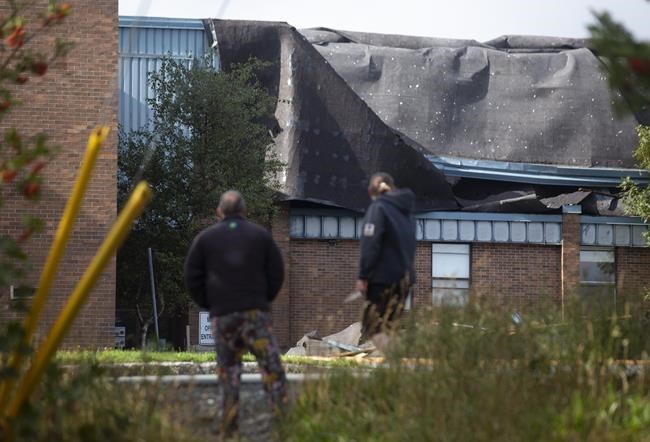ST. JOHN'S, N.L. — The City of St. John's is asking residents to stay home out of it — as the Newfoundland and Labrador saying goes — so crews can clean up the torn branches, downed power lines and scattered debris flung about the streets by hurricane Larry.
The storm made landfall as a Category 1 hurricane along the southern coast of the island at 11:45 p.m. Atlantic time on Friday, bringing sheets of rain and sustained winds of up to 130 km/h across the Avalon Peninsula, which includes the provincial capital of St. John's. Wind gusts reached at speeds as high as 182 km/h, according to measurements at the Cape St. Mary's Lighthouse.
The winds resulted in massive storm surges that brought waves up onto the road in places such as St. Vincent's, a popular spot to watch whales along the southern Avalon. In St. John's, the streets were lined with branches torn from trees, debris pried from houses and, in the Rabbittown neighborhood, a tossed-about easy chair.
"Hurricane Larry caused a significant amount of tree and property damage throughout our city," said St. John's Mayor Danny Breen said at a news conference Saturday.
Still, he said, "it could have been a lot worse."
Larry came barreling across the Atlantic and up into Placentia Bay, a wide expanse of water separating the Avalon Peninsula from the rest of the island, just as high tide set in. The storm surges combined with the high water levels wreaked havoc in some of the coastal communities along Placentia Bay.
Alex Best woke up Saturday morning to find his wharf in Southern Harbour had just about washed away -- and it almost took his boat with it.
The 86-year-old retired fisherman said he hasn't seen high water conditions like those wrought by Larry in many decades.
"Our environment's going so bad, I mean that's what's causing us to have so may storms so often now," he said in a phone interview Saturday. "And we're not doing anything to fix it, either -- only letting it get worse all the time."
Sitting on his deck Saturday and surveying the damage, Best said he's taking it all in stride.
"One day at a time," he said. "As long as you're able to get up and go, that's the main thing."
Along the western coast of Placentia Bay, in Marystown, the fire department had to evacuate two houses because the water was creeping up to their front doors, said Fire Chief Justin Bolt. "Residents in that area hadn't experienced the water to that height from previous storms," he said. "There was a personal wharf in that area that they just managed to secure to prevent it from going afloat."
Larry felt comparable to hurricane Igor, Bolt said, which caused widespread damage across the island in 2010 and even swept a man out to sea.
Back in St. John's, nearly 10,000 people in the area were still without power on Saturday evening, Newfoundland Power's website said. Earlier in the day, more than 30,000 in the metro region were in the dark. The winds tore part of the roof of Mary Queen of Peace Elementary School and it lay in a heap of siding and nail-riddled boards some distance away. A huge blue tent set up along Quidi Vidi lake to house a music festival was stripped to its frame, and the road-facing windows were shattered in an empty building in the nearby Rawlins Cross intersection.
But people stayed inside as the winds did their worst, and nobody was hurt, Breen said. He noted the last time he assembled media for a press conference following a weather emergency, it was January 2020, after the record-breaking snowstorm now called "Snowmageddon." That storm forced city officials to declare a state of emergency for about a week.
That won't happen this time, Breen said. If people stay off the roads and let crews clean up, he said life in St. John's post-Larry would return to normal by Sunday.
This report by The Canadian Press was first published Sept. 11, 2021.
Sarah Smellie, The Canadian Press



